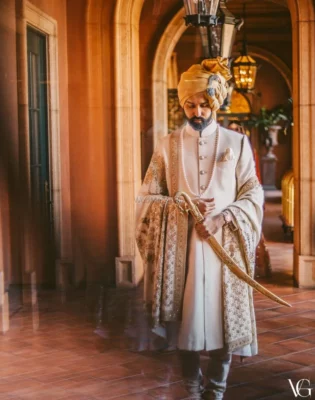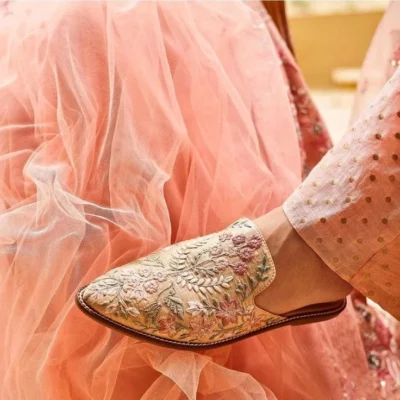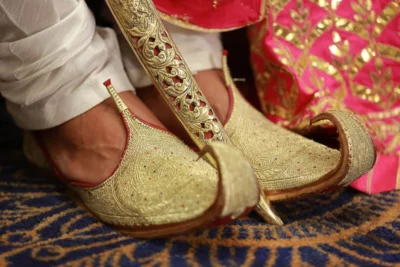In Indian weddings, where traditions blend seamlessly with modern styles, the groom’s attire is a canvas waiting to be adorned with exquisite accessories. A groom needs to look regal and dashing hence every element from head to toe, needs to be perfect. Let’s delve into the rich tapestry of Indian groom’s accessories, each piece weaving a story of heritage and style.
-
Turban (Pagdi)
Just as the Indian bride is incomplete without the traditional bridal attire and jewellery, the Indian groom’s ensemble is incomplete without the traditional turban, also known as the pagdi or safa. The turban is not just a piece of cloth wrapped around the groom’s head, it’s a symbol of honour and pride. In India, pagdi has been relevant since ancient times, but the style of pagdi keeps changing according to the diverse locations. Various diverse regions boast unique styles, colours, and materials for turbans. From the vibrant Rajasthani Safa to the traditional Topor in West Bengal, each variation reflects the groom’s cultural background. The turban is often adorned with safa chains and brooches or kalgi – a jewelled ornament, the turban is a majestic crown that completes the groom’s royal look.
-
Necklace (Haar) & Earrings
Who said that jewellery is just for the bride, the groom’s jewellery is no less significant than the bride’s. A heavy gold necklace, known as haar, adds opulence and grandeur to the groom’s ensemble. Intricate designs and gemstone embellishments make it a striking accessory. Paired with this, an earring adds even more culture and royalty, the groom’s earrings, usually studs or hoops, further enhance the overall appeal, creating a balanced and harmonious look.
-
Sword (Kirpan)
A kirpan, or ceremonial sword, is a quintessential accessory symbolizing valour and strength. Worn with the groom’s attire, it represents the groom’s readiness to defend and protect. Moreover, a sword adds a regal and royal look to the overall appearance of the groom. Elaborately designed hilts and scabbards elevate the kirpan from a functional item to a decorative piece that contributes to the groom’s majestic appearance.
-
Wrist Adornments
Bracelet (Kada) & Watch – The groom’s wrists are adorned with a kada, a sturdy bracelet, symbolizing strength and endurance. Paired with a stylish watch, this combination strikes a balance between tradition and modernity. If you wish to add a personal touch to the accessories you can get the kada engraved with initials of you and your loved one or even religious symbols, adding a personal touch to the ensemble.
-
Sherwani & Shawl
The sherwani, is the focal point of the groom’s attire. Elaborate embroidery, rich fabrics, and contrasting colours make the sherwani a true work of art. To add sophistication you can drape a shawl over your shoulder. The colour of the shawl can be coordinated with the bride’s attire, the sherwani and shawl create a harmonious and visually appealing bridal couple.
-
Mojdis, Footwear Elegance
Mojdis, traditional Indian footwear, complete the groom’s ensemble. These intricately embroidered shoes add a touch of luxury to the overall look. This footwear is not just regal but also super comfortable. There has been a new trend in town where grooms get their footwear personalized with whichever details they wish to add. These add a regal touch to the groom’s steps, making every walk down the aisle a royal procession.
-
Brooches and Buttons
When it is your wedding you can’t afford to miss out on anything, all the tiny elements that go into the outfit matter. Brooches and decorative buttons play a crucial role in fine-tuning the groom’s ensemble. These small yet significant accessories are often adorned with precious stones, pearls, or intricate designs. These broaches are pined on the sherwani, enhancing its overall charm. These brooches and buttons come in several designs from floral patterns to symbolic motifs, these finishing touches contribute to the groom’s impeccable style.
-
Sehra
if you are a Bollywood buff then you must have listened to the song ‘dulhe ka sehra suhana lagta hai’ from the movie Dhadkan. Sehra is such an important part of Indian grooms attire that almost all the grooms incorporate it in their ensemble. The sehra is a traditional veil worn by the groom, covering his face before the wedding ceremony. Traditionally sehra is woven with flowers, beads, and delicate threads. As the groom unveils his face during the ceremony, it symbolizes the transition from a bachelor to a married man.
Conclusion
In the kaleidoscope of Indian groom’s accessories, each element tells a story – a narrative of tradition, symbolism, and personal style. From the majestic turban to the subtle brooches, these accessories contribute to the groom’s overall charisma, creating a timeless and elegant look that transcends trends. As weddings evolve, the essence of these accessories remains, weaving a tapestry of cultural richness. The Indian groom’s ensemble is not just an outfit; it’s a masterpiece, carefully curated to celebrate love, heritage, and the promise of a beautiful journey ahead.



























